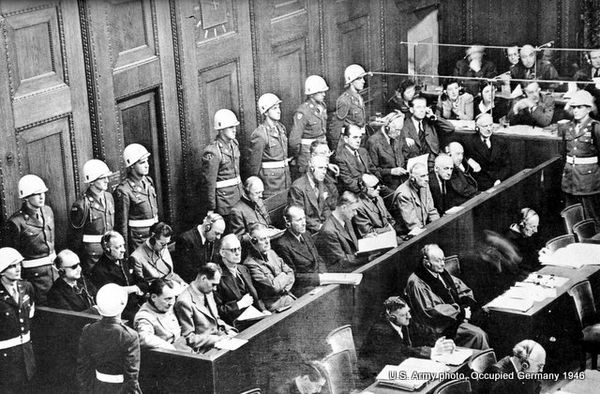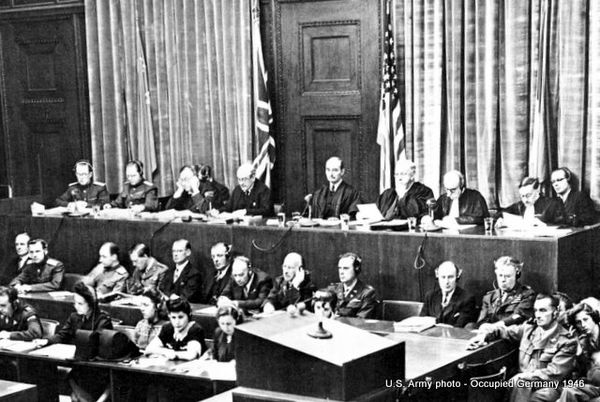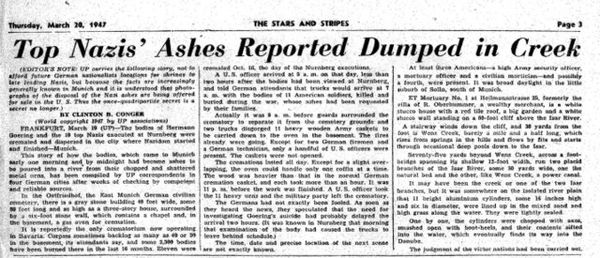The day of life and death in Nuremberg - Occupied Germany 1946
Aug 20, 2017 02:31:54 #
After the Nuremberg International War Crimes Tribunal wrapped up the prosecution of twenty-one surviving Nazi leaders in late August, 1946, the eight judges (one main and one alternate each from America, Britain, Russia and France) withdrew to deliberate.
Only the four main judges had voting powers in the verdicts and sentences.
While the month-long deliberations proceeded behind closed doors, the prisoners had a respite. Their American jailer, Col. Andrus, eased the solitary confinement restrictions and permitted the prisoners to mingle and socialize among themselves, as well as to see and chat with their spouses and children (but through a grill) until two days before the court returned their verdicts.
On September 30 the Palace of Justice was besieged by huge crowds wanting to pass through the only entrance, fighting to be part of the historic closure of the International Tribunal. The MPs were not happy.
The packed audience (not many Germans) sat through some five hours of matter-of-fact summations of the Nazi Party's history, from 1919 on. followed by their aggressions during World War II, followed again by judgments on the criminal actions of major organizations (the SS, the SA, etc.). All for the record.
October 1, 1946, was the real Judgment Day. Hot and humid, and there was no air conditioning in the crowded building.
During the morning, while the twenty-one prisoners and the packed courtroom tensely listened, the four main judges alternately read off the individual charges and verdicts for each prisoner. Eighteen "Guilty" and three "Not Guilty" verdicts. The lucky trio, stunned by their good fortune, were offered the option of immediate release, but chose to stay for lunch.
Then everybody broke for lunch.
In the afternoon, the courtroom was again packed -- but the dock was empty. Then each of the eighteen remaining prisoners was brought in separately and stood alone, facing the judges. Only one of the four main judges read the sentence while the prisoner listened (via headphones) to the interpreter. After each sentence had been pronounced, the prisoner was removed from the court in shackles, to be replaced by the next man who was sentenced by another judge.
Seven of the prisoners received jail sentences, although several pleaded to be shot by a firing squad. The shortest sentence was ten years of solitary confinement in Berlin's Spandau Prison; the longest was life imprisonment. They were hustled off to cells in a separate section of the prison to await transfer.
The remaining eleven prisoners learned their fate was death by hanging. That didn't suit the military Nazis, who felt they deserved the honor of a firing squad. The doomed men were returned to their old cells, where a psychiatrist was available for counseling.
The operations were now taken over by the grim quadripartite Allied Control Council of the four occupation zones. No more lawyers. Just guards, a chaplain, and the hangman.
Master Sgt. John C. Woods, the official occupation army hangman, headed a crew who built three black gallows in the Palace of Justice gymnasium and assembled eleven wooden coffins suitable for cremation. Burials were prohibited,
Only ten prisoners were executed on October 16, 1946, because top Nazi Hermann Goering eluded the gallows by swallowing a poison capsule in his cell, shortly before midnight. The hangings began at 1:00 AM and concluded at 2:45 AM.
Some thirty observers witnessed the executions, but the Tribunal's prosecutors were barred by the Control Council. Permission was granted to smoke during the procedures.
Two reporters from each occupation zone's government were authorized to attend. The American press was represented by Kingsbury Smith of the International News Service, who was chosen by lot from the reporter pool. His detailed report, "The Execution of Nazi War Criminals," is posted on the Internet.
Only the four main judges had voting powers in the verdicts and sentences.
While the month-long deliberations proceeded behind closed doors, the prisoners had a respite. Their American jailer, Col. Andrus, eased the solitary confinement restrictions and permitted the prisoners to mingle and socialize among themselves, as well as to see and chat with their spouses and children (but through a grill) until two days before the court returned their verdicts.
On September 30 the Palace of Justice was besieged by huge crowds wanting to pass through the only entrance, fighting to be part of the historic closure of the International Tribunal. The MPs were not happy.
The packed audience (not many Germans) sat through some five hours of matter-of-fact summations of the Nazi Party's history, from 1919 on. followed by their aggressions during World War II, followed again by judgments on the criminal actions of major organizations (the SS, the SA, etc.). All for the record.
October 1, 1946, was the real Judgment Day. Hot and humid, and there was no air conditioning in the crowded building.
During the morning, while the twenty-one prisoners and the packed courtroom tensely listened, the four main judges alternately read off the individual charges and verdicts for each prisoner. Eighteen "Guilty" and three "Not Guilty" verdicts. The lucky trio, stunned by their good fortune, were offered the option of immediate release, but chose to stay for lunch.
Then everybody broke for lunch.
In the afternoon, the courtroom was again packed -- but the dock was empty. Then each of the eighteen remaining prisoners was brought in separately and stood alone, facing the judges. Only one of the four main judges read the sentence while the prisoner listened (via headphones) to the interpreter. After each sentence had been pronounced, the prisoner was removed from the court in shackles, to be replaced by the next man who was sentenced by another judge.
Seven of the prisoners received jail sentences, although several pleaded to be shot by a firing squad. The shortest sentence was ten years of solitary confinement in Berlin's Spandau Prison; the longest was life imprisonment. They were hustled off to cells in a separate section of the prison to await transfer.
The remaining eleven prisoners learned their fate was death by hanging. That didn't suit the military Nazis, who felt they deserved the honor of a firing squad. The doomed men were returned to their old cells, where a psychiatrist was available for counseling.
The operations were now taken over by the grim quadripartite Allied Control Council of the four occupation zones. No more lawyers. Just guards, a chaplain, and the hangman.
Master Sgt. John C. Woods, the official occupation army hangman, headed a crew who built three black gallows in the Palace of Justice gymnasium and assembled eleven wooden coffins suitable for cremation. Burials were prohibited,
Only ten prisoners were executed on October 16, 1946, because top Nazi Hermann Goering eluded the gallows by swallowing a poison capsule in his cell, shortly before midnight. The hangings began at 1:00 AM and concluded at 2:45 AM.
Some thirty observers witnessed the executions, but the Tribunal's prosecutors were barred by the Control Council. Permission was granted to smoke during the procedures.
Two reporters from each occupation zone's government were authorized to attend. The American press was represented by Kingsbury Smith of the International News Service, who was chosen by lot from the reporter pool. His detailed report, "The Execution of Nazi War Criminals," is posted on the Internet.
Twenty-one Nazi prisoners sat on hard flat boards in the dock

Eight judges included (L to R) two Russians, two British, two Americans and two French

On March 20, 1947, The Stars and Stripes newspaper published this report

Aug 20, 2017 03:01:02 #
RichardQ wrote:
After the Nuremberg International War Crimes Tribu... (show quote)
Thank you very much for this post. I highly value your first hand accounts and the body of work your UHH posts reflect. Much appreciated Richard!
Aug 20, 2017 03:19:18 #
rockdog wrote:
Thank you very much for this post. I highly value your first hand accounts and the body of work your UHH posts reflect. Much appreciated Richard!
Thank you, rockdog, much appreciated. I have to correct one thing -- I was in the occupation during thr Tribunal but I never actually witnessed it, because we were discouraged from traveling anywhere "in country" without authorization. This was due to friction between different forces. I was in the Army Air Force (AAF) but the various cities and towns were under units of the Third Army, so any airmen without papers could face arrest. I was threatened with arrest once while on a pass to Berchtesgaden in winter, because I was wearing an Air Force parka in the bitter cold. That was not an authorized uniform among the Infantry in those days. I can't claim first-hand experience in everything I write about, but I have plenty of reliable references to support the facts I report. I wish President Trump would be as precise.
Aug 21, 2017 06:20:12 #
Richard, as usual, your posting is spot on and much appreciated. Your historical accuracy is above reproach.
Aug 21, 2017 06:40:06 #
Thanks! I just happened to think a couple of days ago that we hadn't received any stories from you recently.
Aug 21, 2017 08:11:39 #
My favorite comments are the stories you post regarding WWII events. So often they are the stories not found in textbooks, and I love them. Thank you!
Aug 21, 2017 08:41:28 #
Thanks again Richard!!! you've done it again.... educated me a little more.... thanks for the good read hope you put this into a ebook or other thanks again......




RichardQ wrote:
After the Nuremberg International War Crimes Tribu... (show quote)




Aug 21, 2017 08:46:57 #
Aug 21, 2017 10:27:45 #
bthomas42
Loc: North Ridgeville Ohio
I have seen photos of the the 10 that where hanged laying on tables afterward. While stationed in Germany in the 60's the person in charge of the post photo lab was a German photographer during the war, he had had a lot of candid shots of Hitler and others, along with the death shots.
He had the negatives and he let anyone that wanted too print copies of them, which I did about 150 pictures. we could also copy the negatives which I did.
He had the negatives and he let anyone that wanted too print copies of them, which I did about 150 pictures. we could also copy the negatives which I did.

Aug 21, 2017 10:41:00 #
Thank you so much Richard for that historic input. You have an amazing talent to record history. I was 14 years old at that time and all this more or less escaped me. Stay Well.
Aug 21, 2017 12:45:51 #
Aug 21, 2017 13:37:35 #
The war crime trials were a farce. The Russians were just as guilty of many of the cited crimes as the Germans were. The Russians invaded Finland without provocation in 1938 (crimes against peace). When the Germans invaded Poland in 1939, the Poles set up a defense in depth in front of Warsaw. They thought they could stop the Germans at this line. Then the Poles found out that Russia had invaded Poland from the East. (More crimes against peace) When the Germans invaded Poland, the British and French immediately declared war on Germany. Why was there no declaration of war against Russia? The 10,000 Polish officers the Russians captured were executed in the Katyn Woods. (Crimes against humanity) The Soviets should have been in the defendant's docket right along with the Germans. And I will never know why we gave equal footing of any kind to the French. They lost the fight against the Germans and actually resisted (forcefully) the Allied landing in North Africa.
Aug 21, 2017 14:30:57 #
What is strange to me, is that when I was in the service from November 1945, and in Germany from January 1946 to September 1948, and finally discharged in December 1948, the only time I heard that there was a Stars and Stripes newspaper was after I left the service.
Aug 21, 2017 14:50:37 #
sirlensalot
Loc: Arizona
rightofattila wrote:
The war crime trials were a farce. The Russians w... (show quote)
We should have listened and taken action on General Patton's advice to keep heading East after Russia was allowed to capture Berlin.
Aug 21, 2017 21:26:01 #
rockdog wrote:
Thank you very much for this post. I highly value your first hand accounts and the body of work your UHH posts reflect. Much appreciated Richard!
Couldn't agree more with this sentiment!!!
If you want to reply, then register here. Registration is free and your account is created instantly, so you can post right away.









